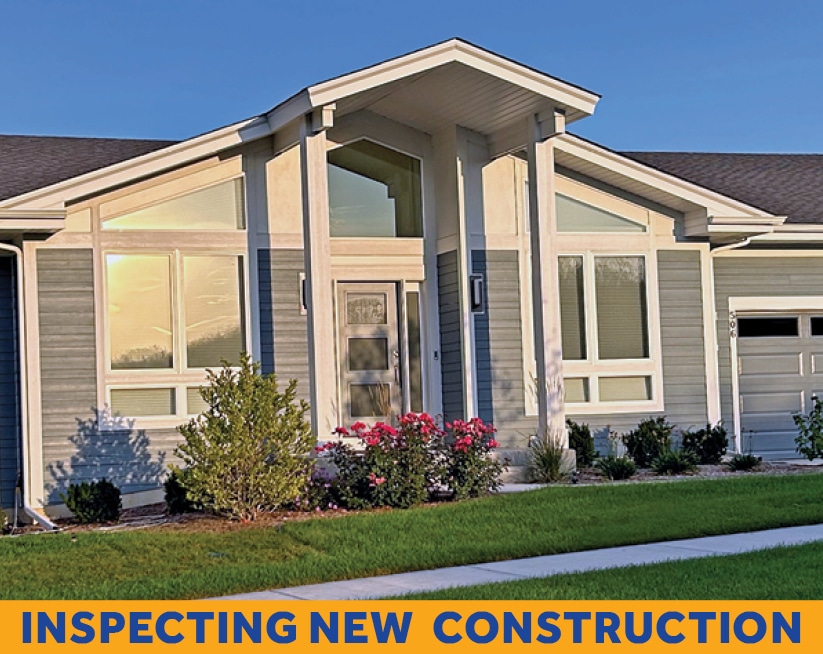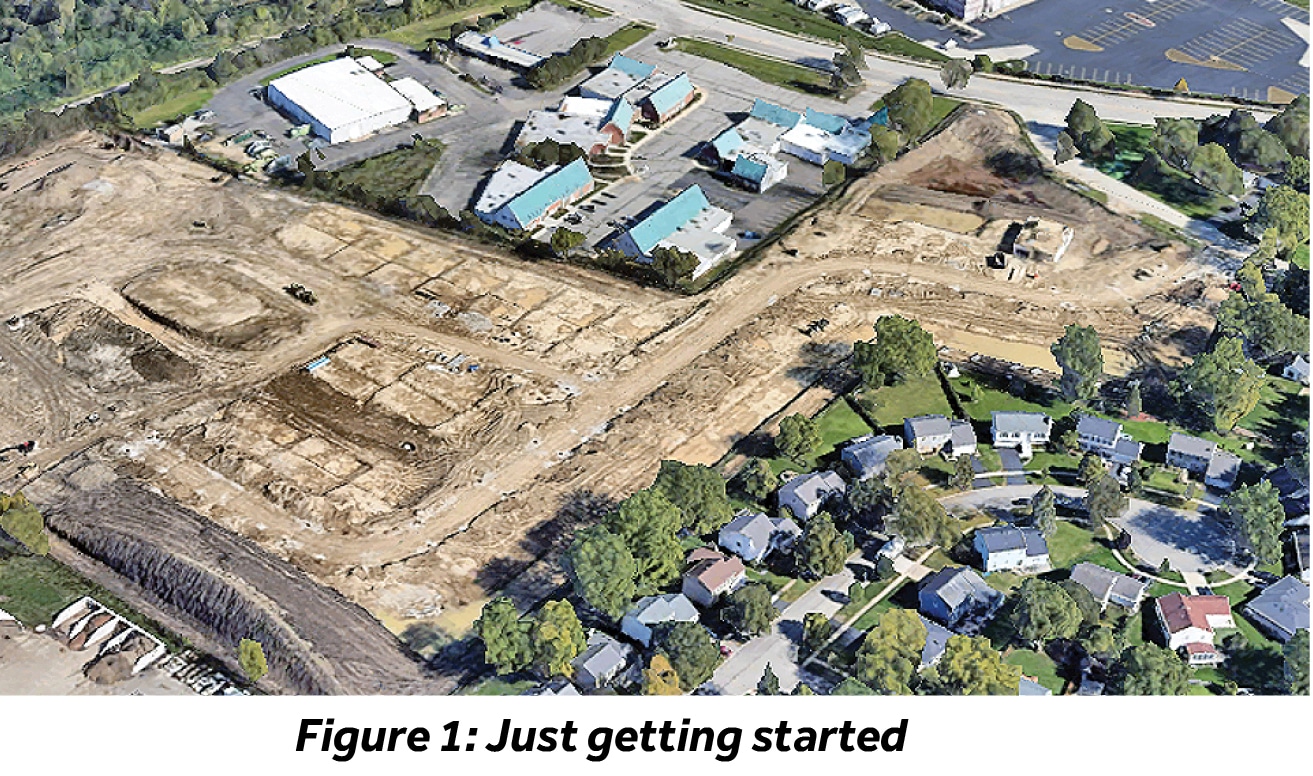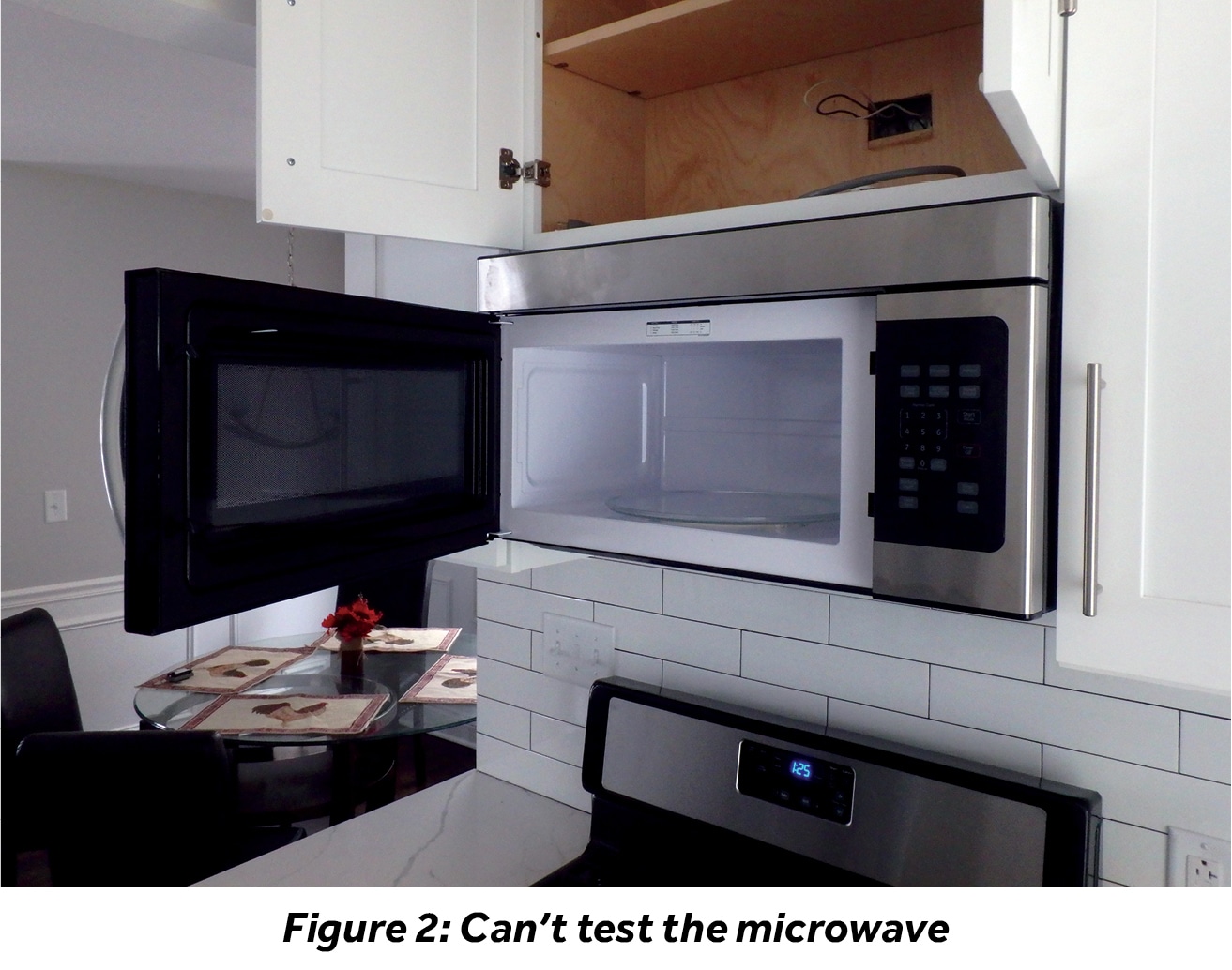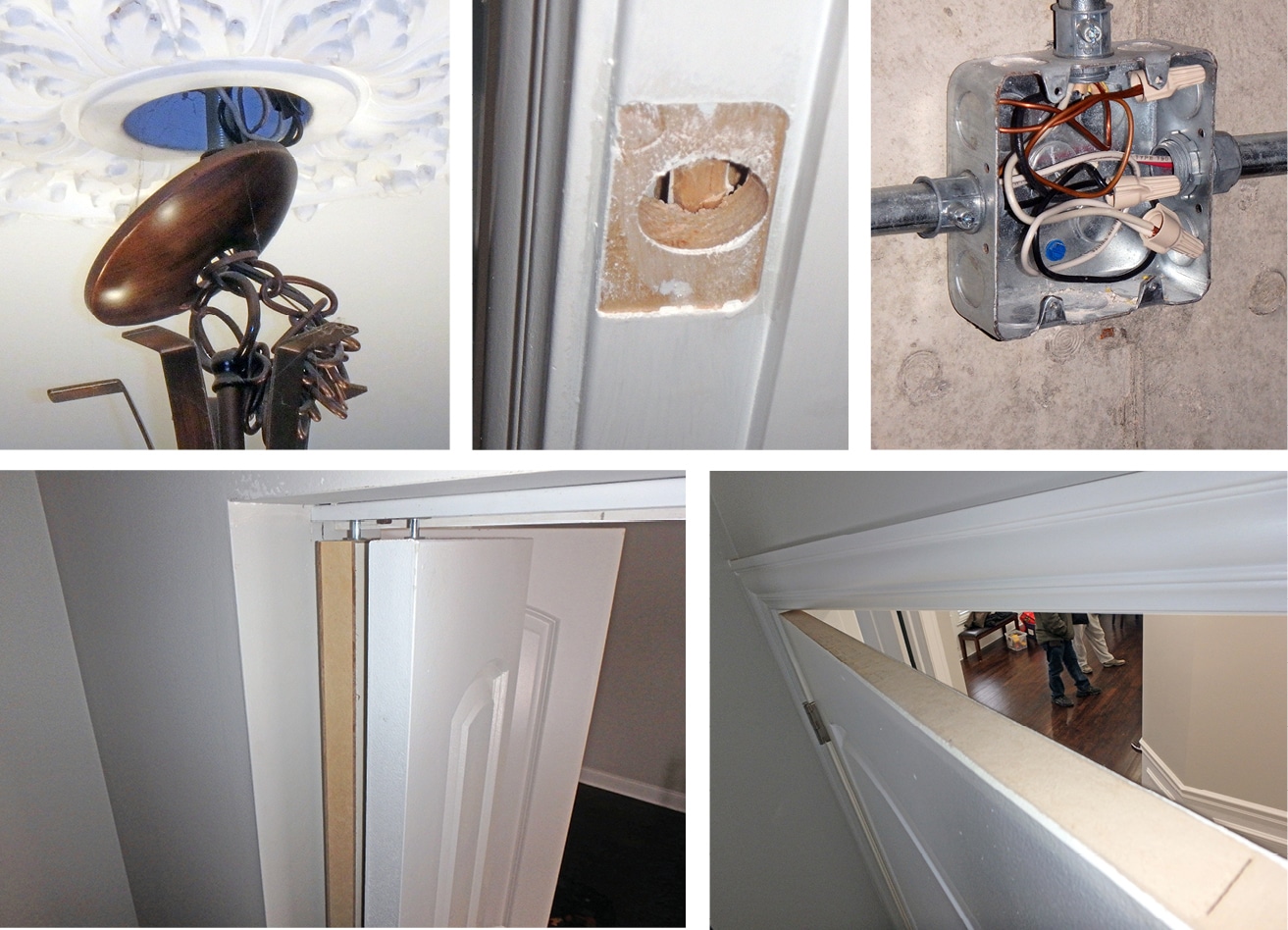Inspecting New Homes

The construction standards you learned from your experience as an inspector or from educational courses are the same as in new construction, but the process of inspecting a new home differs from that of existing homes.
Many of the issues or defects found in existing homes were there from day one. Your knowledge and experience of inspecting occupied homes will give you a sense of what you’ll find in new homes, aside from age-related issues or the wear and tear of an older home having been lived in. You may notice that homes being built today have similar issues to the 20- or 30-year-old homes you’ve inspected in the past. The subcontractors and tradespeople the builders use affect the quality of homes built. Some builders employ the same crews for many years, and others change crews every year or two. Some tradespeople may have learned their craft from their fathers, while others learned from formal, hands-on classes.
You will observe a few of every kind of issue in a new home. If there is no outstanding weather-related construction to be done, there won’t be too many defects to report. You might see incomplete work, code compliance issues, or poor workmanship. These issues may exist in any new home to one degree or another. You already know the construction standards, but now I will introduce you to the inspection process for newly built homes.

Your Preparation
New home builders may require you to be insured to the policy limits they specify. Some will have higher insurance coverage requirements, and they may ask you to provide a certificate of insurance that lists them as an additional insured. The homebuyers may not know the specifics of these requirements, so check with the builder and your insurance agent to work this out prior to the inspection appointment.
Get familiar with where the home you’re inspecting is located. Whether it’s in a large community, urban infill, or is a custom home in a sparsely populated area, newly platted property may not have its address on Google Maps or your preferred navigation service yet. Some municipalities don’t assign the street address to the property until the construction permit is issued. You may need to navigate to the new home by knowing the name of the subdivision and the lot number; Google Maps may not be updated for five
or more years.
In large communities where you might inspect multiple new homes over the course of one or more years, meet the construction manager and request a map of the new subdivision. Again, the maps used to direct construction traffic to the correct site may only have lot numbers and not street addresses yet. Introduce yourself to the project manager or superintendent the first time you inspect one of their homes. The builder’s sales office may also be able to direct you to the house you’ll be inspecting. Or, set an appointment to meet with the homebuyer at a nearby intersection and let them lead you to the house.
You may notice that homes being built today have similar issues to the 20- or 30-year-old homes you’ve inspected in the past.
Allow Enough Time for Inspection
Even though the house is new and there shouldn’t be a lot of issues to report, it’s possible the builder will want to be present when you inspect the home with the buyer, and this can take more time than a typical inspection of an existing home.
Having the builder walk with you during the inspection may also put you under pressure to get the inspection done in less time than you would typically. Some builders may have the superintendent or customer service rep conduct an orientation with the buyer before or after your inspection. Ask your homebuyer whether they’ve had their orientation with the builder, or whether it will be done on the day of closing. Don’t be surprised if you run into a situation where the builder doesn’t provide the homebuyers with any orientation, but I think that would be rare.
Get to Know the Buyers
Homebuyers can be a bundle of nerves and have questions you don’t expect. Maybe the homebuilder eased their concerns by answering all of their questions before you inspect the home, but it could be just as likely that they did not.
Remember that the purchase of a home is the largest single financial transaction for most families. Regardless of whether your clients are first-time homebuyers or have purchased a new home in the past, having a new home built for them can be stressful given the large number of decisions they have to make. If the buyer is having a custom home built, they may have been working with this builder for one or two years already. Take all this into consideration when you meet them for the first time. They might even act as though the builder is an old friend. Choose your
words wisely when talking about the builder.
Experienced homebuyers might be calm, or they may have heard stories of what it’s like to buy a new home from a builder. You might have a customer who is very experienced because they are an investor planning to rent the property to someone else for a few years while the value of the property appreciates. Investors will likely approach the inspection differently than a family. They may even take little interest in the small details you would normally show to any other homebuyer.
Inspect the Home with the Buyers
If your client isn’t planning to attend the inspection, be prepared to remind them of its importance. Your inspection is much more than just ticking the boxes.
Learn the Vocabulary
Depending on where you work, homebuilding companies may be organized with employees with different job titles. Some builders may call the onsite supervisor of construction a project manager or superintendent. Elsewhere, the person in charge of construction may be called the builder.
There may also be unique names for parts of the house and property depending on the region. Sometimes this is done by the home builder to differentiate themselves. Stop at the sales office and pick up a brochure for the home style your customer has purchased to learn the room names. Bedroom #1 may be called the master bedroom or the master suite. Other builders may describe the largest bedroom in the house in a completely new way.
Deferred Work
Some construction items may be incomplete at the time of the inspection for many reasons, including weather and seasonal work.
Seasonal work may be different in your geographic area and climate. Here are some examples of incomplete work and other things to watch for:
- The air conditioning equipment may be installed, but it may not be ready for use. And regardless of whether it has been charged with refrigerant and can be turned on or not, it may not yet be serviced and balanced by the HVAC technician.
- The driveway should at least have gravel, even if the asphalt or concrete has not yet been installed.
- The public sidewalks, service walks, patio, wood decks, final grade, sod, seed, and landscaping may be complete or not. The home may be partially cleaned, and the homebuyer should expect a more thorough cleaning prior to moving into the home. Be prepared to help the buyer itemize what is not finished and any areas not cleaned on the day of inspection. Some builders will leave trash in the garage, which may make your inspection difficult.
- Window screens may not yet be installed to prevent damage.
- Final clean, or construction clean? Will there be one more “re-clean?” Some builders provide what they
call a construction clean, which is not much more than sweeping the floors. Other builders are meti-
culous about cleaning everything, including vacuuming and wiping out every cabinet shelf and drawer. - Outbuildings, swimming pools, and fences may be deferred by the buyer and may not be a part
of the contract with the builder. - Closet shelves and built-ins may or may not be included in the sale of the home.

Test Everything, Look Everywhere
Everything should look and work like new—every window, light, door, switch, outlet, drawer, and more. Check that every shelf was installed with every shelf clip in place. Use a stool or stepladder to look on top of the cabinets or use a selfie stick to take high-up photos for things like misplaced tools.
Check that every appliance is plugged in, turned on, and working. Check for the anti-tip device on the oven. If the builder supplied and installed the laundry appliances, check those, too. Look for every door stopper, and test the self-closing hinges on the garage service door.
If the home has a basement or crawl space that includes a sump pump, investigate to be sure it has no construction debris in it. There can be pieces of concrete at the bottom or wood floating on the top. Basement window wells should be clean, too. Construction debris gets into everything. Check inside every floor register for construction debris. Use a mirror to look deep into the ductwork, or take a photo inside the ductwork.

In the final hours of construction, things can be bruised or broken. I call that “trade rash.” The scuffs and scratches are everywhere. Bring a pack of removable round dots and let the homebuyers mark the walls wherever they find scuff marks. Document if the carpet is dirty. Ask the builder if there will be a “re-clean” on the morning of the move-in. If the house looks like it has never been cleaned or needs a touchup, include that in your report.
Look for animals—dead or alive. It doesn’t take long for them to get into crawl spaces and attics of homes under construction. Birds will build nests in the trusses and rafters when there are no doors and windows on the house in early spring. In the fall, rodents may come in for a warm place in winter. While the builder may not take responsibility for animals or insect infestation, the buyer will appreciate knowing who moved into their home before they did.
Walk back and forth across every carpeted floor to see if any construction debris has been trapped under the carpet.
Look for mold. It can grow anywhere on bare wood in a short period of time during construction.
Place an old sheet or drop cloth on the floor under your ladder when you go into the attic.
Many builders will not allow you to walk on the roof.
You can inspect the roof from the eaves. In the winter, new shingles may not have successfully sealed themselves down and they can be easily lifted by
high winds. Report loose shingles that you observe.
Warranty papers and owner manuals are important. Most builders today gather the warranty and owner’s manuals for every consumer product provided by them. It is also possible that when you first look inside the dishwasher or open the oven, you will see the owner’s manuals, and perhaps some of the internal parts will have not been unpacked. All kitchen appliances should be fully unpacked prior to the day of inspection.
Report all appliances that are not unpacked. Ask the builder to unpack and turn on all appliances while you’re doing your inspection. It would be embarrassing for them to learn that the dishwasher was never hooked up or the icemaker in the freezer was never connected to the water supply. This search for owner’s manuals will include the appliances like the furnace, water heater, and air conditioner. The homebuyers will want all of the manuals for the kitchen appliances, too. Better builders might gather them together and put them in a binder. High-volume production builders may simply gather them and put them in a kitchen cabinet drawer. Some builders let everything drop to the floor and sweep it all up on the last day and throw everything into the trash—including many owner’s manuals. I can’t predict what you will experience, but give it your best shot to help your client know where all their paperwork is.
When builders supply a binder with the owner manuals, this often includes a printed copy of their builder’s warranty and service policies. Many builders will include a page of phone numbers that include all the major utilities, like refuse collection, Internet provider, and cable companies. Some builders deliver this binder when everyone meets at the title company to sign the final papers. This may be when the builder delivers the remote control devices for overhead door openers and keys to the house, too. Ask the builder for the keys and the overhead door remote control devices, and test every door unless the builder is there to demonstrate this himself. This is one of the reasons why it is recommended for the builder to be at the house during your inspection.
If keys and other electronic devices are not available to be tested, include this in your report. Some builders do not change the entry door locks until the morning of the closing.
Demonstrate for the homebuyer how to cleanthe aerators on the kitchen and bathroom faucets. Most builders will do this during their orientation,
but you should check it as well.
Aerators in newly built homes can plug up in the first few days of use after the buyers move in when debris from construction, which is often small shavings of plastic or copper, get flushed out of
the water distribution pipes through the faucets.
Run both the hot and the cold water for an extended time in every sink. An experienced cleaning company will run the water for an extended time, but you should do it yourself as well. The debris will come from both the hot and the cold water distribution pipes. Flush the toilets more than once.
And don’t be shy about recommending a sewer scope. New sewer laterals can settle or be damaged during construction.
Options and Product Selections
Except for a custom-built home built from a design created exclusively for the client, builders will typically start from standard designs and offer a wide variety of options and selections. This is often a lengthy process where the buyers will meet with a designer or decorator to select the color and grade of cabinets, flooring, lighting, and plumbing fixtures. They may also allow buyers to request custom options no other home will have. These may require modification of the design documents, such as changing the size or location of windows and doors. Perhaps the customers have requested modifying the home to be partially or completely handicap accessible.
Perhaps the custom change is to make one bathroom handicap accessible for a family member. Some of these design decisions are made after the builder has begun construction. As a home inspector, you can help the buyer check that all the options have been built into the home. Your eye for details may see things that are missing or installed incorrectly or incompletely, and you can help your client recognize these errors and omissions.
If you don’t feel capable of addressing these questions, you may wish to disclaim that you confirmed the completeness or correctness of any options. If you choose to provide this additional service, you may wish to charge an additional fee.
On a custom home, this service would be offered by the architect who designed it; you should note when that service is to be done by others and you were
not involved.
Training for the Newest Standards
When you inspect new homes, think of the future. Stay ahead of the curve by studying the new codes as they’re adopted and taking every available CE credit course, webinar, and in-person training available.
If you haven’t done many new construction inspections, you may want a mentor.
The way homes are built is guided by the principles of building science now more than ever. Set your training goals to include courses that will include building science concepts. Codes and standards will always evolve and adapt to new materials and new construction methods. You will want to be well trained.
To Read the Full Article
ASHI offers its members unparalleled resources to advance their careers. ASHI offers training for inspectors at all levels of knowledge and experience, including resources about all major home systems. Members benefit from a vast network of experienced professionals, providing a community for mentorship and knowledge sharing..
In this Issue
A Greeting from the New ASHI President
Are Home Inspectors in Demand?
Postcards from the Field
Right is right, and right always prevails.
New Year, New Opportunities
Bringing the Experts to You
New Construction Snafus
Advertisement
InspectorPro Insurance
FIND A HOME
INSPECTOR
Professional Networking
Grow your professional network, find a mentor, network with the best, and best part of the community that’s making home inspection better every day.
